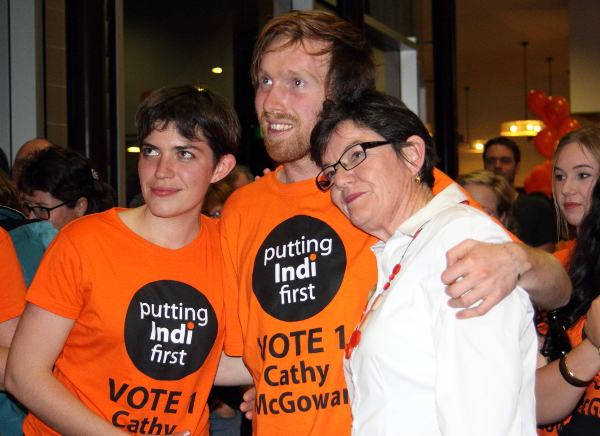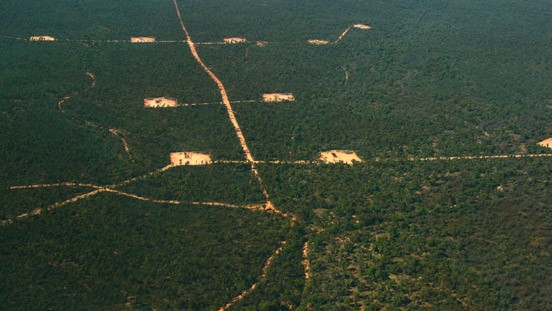
Cyclone Debbie off Queensland. Image by BOM from Himawari satellite
Tropical Cyclone Debbie is forecast to cross Central Queensland coast on Tuesday morning as a Category 4 Severe tropical cyclone. It will bring destructive winds greater than 200km per hour plus a storm surge with a king tide innundating low lying coastal properties, and torrential rain causing flooding. It is also cooling sections of the Great Barrier Reef reducing coral bleaching from an extensive and long lasting marine heatwave.
Tropical Cyclone Debbie draws heat from the unusually warm waters of the Coral Sea. This will help it increase in intensity to achieve possibly Category 4, and an outside chance as a Category 5 severe tropical cyclone before it strikes land.
It is the first tropical cyclone to strike the north Queensland coast since Cyclone Nathan in March 2015. Although it may not be as strong, it is being compared in size and extent to the Category 5 cyclone Yasi from 2011.
The destructive winds and storm surge may wreck havoc on low lying coastal areas when the cyclone comes ashore.
The cyclone brings substantial cloud cover to the region and helps to cool the general water temperature. It may thus help limit coral bleaching, which involves the expulsion of Zooxanthellae by the coral polyps when the waters get too warm. For those coral reefs in the southern reef system already suffering mild coral bleaching, it can help them recover more quickly. But for many corals the cyclone cooling the waters may already be too little, too late.
We needed the cyclone in February to make a real difference, but it may help mildly bleached corals in the south regain their colour faster https://t.co/LKLiExVjp1
— Terry Hughes (@ProfTerryHughes) March 23, 2017
Great Barrier Reef corals have again been subjected to extensive stress by elevated water temperatures in a marine heatwave. While the 2016 extensive coral bleaching was related to elevated temperatures from an El Nino event. Water temperatures have remained anomalously high this year while the El Nino Southern Oscillation (ENSO) was in a neutral phase.
At one stage tropical cyclones were seen as a primarily destructive force for coral reefs, but now they are seen as also bringing cloud cover and suppressing sea surface temperatures a little and preventing greater coral bleaching.
Cyclone Debbie isn’t the embodiment of climate change. But it is occurring in a climate changed world.
Tropical Cyclones are likely to reduce in frequency, but the numbers of high intensity cyclones are likely to increase. Warmer ocean waters can contribute to the stronger cyclone intensity.
Higher atmospheric temperatures mean that more water vapour can be held aloft and therefore dumped causing high torrential rainfalls and local flash flooding and landslides. Indeed, the Bureau of Meteorology have issued a flood warning for Cyclone Debbie: “Heavy rainfall associated with Tropical Cyclone Debbie is expected to result in widespread daily totals of up to 200 mm from Monday. Isolated daily totals of up to 400 mm are possible particularly in the coastal catchments in the Flood Watch area.”
Storm surges become more dangerous as they are added to a mean sea surface level already increased by sea level rise.
The 2011 Intergovernmental Panel on Climate Change (IPCC) Special Report on Managing the Risks of Extreme Events and Disasters to Advance Climate Change Adaptation (SREX) predicted that with Tropical Cyclones, Intensity may increase but frequency may stay the same or even decrease. Wind speeds are likely to increase, although perhaps not in all ocean basins. Medium confidence in a projected poleward shift of extra-tropical storm tracks, and a reduction in the average number of extra-tropical cyclones. (I blogged about this report here)
Coral Sea Surface temperatures where #CycloneDebbie currently is measured at nearly 30C a week ago #SST pic.twitter.com/T93l8V7EOV
— John Englart EAM (@takvera) March 25, 2017
#CycloneDebbie forming Coral sea, may reach Cat 4. Second chart shows sea surface temperature anomaly that will help cyclone intensify pic.twitter.com/LyWTNOtQCp
— John Englart EAM (@takvera) March 24, 2017
#CycloneDebbie is travelling across water 26-28C temperature picking up moisture & intensity. SST anomaly is at least 1-1.3C #BOM #meteye pic.twitter.com/YQzru3tDRN
— John Englart EAM (@takvera) March 25, 2017
For Cyclone Debbie coastal warnings from St Lawrence to Cape Tribulation have been issued, but the cyclone path is presently forecast to impact between Hamilton Island and Cardwell with the city of Townsville also being in the impact zone.
Residents are being urged to put in place their emergency plans. The Premier has announced that 25 Schools in the affected area will be closed on Monday.
Already some supermarkets have seen their shelves of bottled water, bread and UHT milk denuded.
Bruce Gunn, Bureau of Meteorology (BoM) deputy regional director compared the storm with Cyclone Yasi from 2011, according to Channel 9 News, “Queensland hasn’t seen a coastal crossing for a couple of years now since Marcia or Nathan in 2015 but I think you could probably say that Debbie’s the most significant tropical cyclone since Yasi,” he said. “Not so much because of its intensity … mostly because of its size and extent. It’s quite a sizable system.”
Yasi caused $800 million in property damage in 2011.
Storm surge
Cyclone Debbie will bring a storm surge, which will be on top of the King tide about to happen. Many low level coastal areas will be impacted by this storm surge with the various Council’s publishing maps of affected areas and urging evacuation of those living in low lying coastal areas.
It’s a new moon on 28th March which accentuates ocean tides. These are forecast tidal figures from the Bureau of Meteorology website:
| Tides along Queensland coast. 28 March 2017 is a new moon king tide | ||||||||
| 28/03/17 | Mackay outer harbour | Laguna Keys | Abbot Point | Townsville | ||||
| LOW | 04:56 | 0.55 m | 05:22 | 0.44 m | 03:34 | 0.62 m | 02:41 | 0.69 m |
| HIGH | 10:54 | 5.93 m | 11:29 | 5.29 m | 09:31 | 3.10 m | 08:55 | 3.67 m |
| LOW | 17:22 | 0.45 m | 17:47 | 0.32 m | 16:04 | 0.61 m | 15:23 | 0.75 m |
| HIGH | 23:20 | 5.76 m | 23:53 | 5.13 m | 21:58 | 2.91 m | 21:20 | 3.51 m |
#CycloneDebbie "4 metre storm surge expected in low lying areas", on @ABCNews24 https://t.co/skBDYyhmmK
— ABC Emergency (@ABCemergency) March 26, 2017
Here is the sea level anomaly projected for Monday 27 March for Queensland coast by the Bureau of Meteorology:
Here is #BOM's sea level anomaly for Queensland coast for Monday 27/3 #CycloneDebbie #stormsurge https://t.co/mCU8dkojCz pic.twitter.com/nPqe7WGrUb
— John Englart EAM (@takvera) March 26, 2017
It is not possible to shelter from storm surge. If you're in a low-lying area, be prepared to evacuate. Plan today.@BOM_Qld #CycloneDebbie
— QPS Media Unit (@QPSmedia) March 26, 2017
Forecast path of Cyclone Debbie (Sunday afternoon)
Townsville:
Is your home at risk of #stormsurge with #CycloneDebbie? Here is @TCC_News's storm tide guide for #Townsville: https://t.co/ncUIoWxvCn pic.twitter.com/ZvPKiGeaNo
— ABC Emergency (@ABCemergency) March 25, 2017
Burdekin region:
Here is a full list of storm surge maps for those in the Burdekin region (Ayr and Home Hill). https://t.co/q6tojmhfK4 pic.twitter.com/Q6HRvkgkv6
— Josh Bavas (@JoshBavas) March 26, 2017
Whitsunday:
If in these areas, Don't be complacent:
Whitsunday Council storm surge evacuation maps #cycloneDebbie https://t.co/pAqJTWK3FM pic.twitter.com/WVE8QgFGlG— John Englart EAM (@takvera) March 26, 2017
Mackay:
Is your home at risk of #stormsurge with #CycloneDebbie? Here is @mackaycouncil's storm tide guide for #Mackay: https://t.co/KsWYRhXe6h pic.twitter.com/zvD6aDsSiP
— ABC Emergency (@ABCemergency) March 25, 2017













Have your say